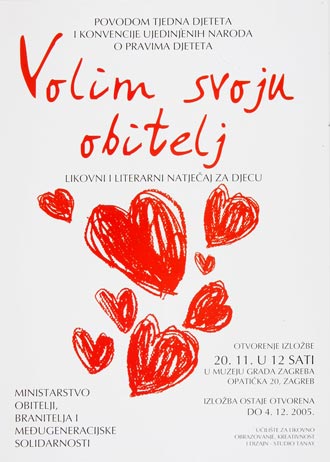Ministry of the Family, Veterans' Affairs and Intergenerational Solidarity in collaboration with Zagreb City Museum, the exhibition of children's artworks
 The competition I love my family offers insight into children’s drawings, paintings and sculptures that reminds us of pictures in a family album and provides a unique personal dialogue of every child with the topic of the meaning of family.
The competition I love my family offers insight into children’s drawings, paintings and sculptures that reminds us of pictures in a family album and provides a unique personal dialogue of every child with the topic of the meaning of family.
The creativity expressed by the works at this exhibition results from an interplay between skill at rendering visual information and levels of emotion. The family as the fundamental unit of society and the way in which children see it is expressed in two different ways. The first is characterized by feelings of harmony that help the child to establish unity between coincidence of portrayal and nature; in the second, this harmony is shown indirectly: coincidence is replaced by the documentary nature of the drawing and objectivity of narration.
The works of pre-school children stand out not only in the use of colour and shape but also in authenticity and originality of execution, where the accidental choice of lines, colours and shapes takes priority over realism. The figure of the mother appears in that period of the child’s life, with an accentuated rendering of her portrait characteristics. Artworks reflect intuitive, spontaneous and cognitive experiences.
In the works of children of higher primary-school levels the observation of characters is based on conceptual thinking which is reflected in the portrayal of figures from their own environment. This can best be seen on drawings on which pupils note a lot of details on portraits in an attempt to persuade us of the truthfulness of the scene that they are showing. The most interesting pictures are those on which the observed, reproduced scenes are transformed into knowledge about what was observed and awareness of oneself. The emphasis is on the expression of internal events, thoughts and feelings.
The need of pupils aged between 11 and 14 to show how they see their own families and express what they think about them tells us not only about the family members but also about the meaning of the environment in which the child lives and its multimedia role models and traditional elements.
The fact that a positive correlation exists between intelligence and drawing abilities indicates the need for an equal approach to the drawings of gifted children and those with special needs. Both groups demand sensitivity and openness towards their capabilities at art expression.
The awarded works show interpersonal relationships that are reflected in the children‘s imagination in encounters with their parents and siblings.
It was hard to separate, among the works chosen, those that deserve a special mention and/or an award. The immediacy of every child’s visual art expression witnesses that the concept of family is a value of inter-relationships, filled with multitude meanings that these rela¬tionships between parents, teachers and children have for every particular child.
The jury evaluated the artworks not only on the basis of their emotional and cognitive characteristics but also acknowledged, on each pupil’s level of achievement, the fact that drawings, paintings and sculptures are the only means of children’s self-realisation and as such they are part of the total impression left by the creative power of a personal art expression.
The jury decided to award and commend kindergartens and schools that had the greatest number of unusual, original and technically well-executed expressions of children’s imagination, the complete self-expression of children with various abilities. These works, once again, we exhibit to our public with the greatest responsibility.
Emil Robert Tanay

